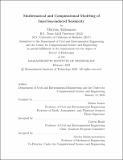Mathematical and Computational Modeling of Injection-induced Seismicity
Author(s)
Alghannam, Maryam
DownloadThesis PDF (9.701Mb)
Advisor
Juanes, Ruben
Terms of use
Metadata
Show full item recordAbstract
It has long been recognized that pumping fluids into or out of the Earth has the potential to cause earthquakes. Some of the earliest field evidence dates to the 1960s, when earthquakes were turned on and off by water injection in Rangely, Colorado. More recently, induced seismicity has been reported worldwide in connection with many subsurface technologies, including wastewater disposal, natural gas storage, enhanced geothermal systems, and hydraulic fracturing. As a result, there has been a growing public concern around the world about the potential seismic hazard and environmental impact of subsurface energy technologies. Understanding the physical mechanisms that lead to induced seismicity is essential in efforts to mitigate the risk associated with subsurface operations. As a first step in this thesis, we develop a spring-poroslider model of frictional slip as an analogue for induced seismicity, and analyze conditions for the emergence of stick-slip frictional instability—the mechanism for earthquakes—by carrying out a linear stability analysis and nonlinear simulations. We found that the likelihood of triggering earthquakes depends largely on the rate of increase in pore pressure rather than its magnitude. Thus, the model explains the common observation that abrupt increases in injection rate increase the seismic risk. Second, we perform an energy analysis using the same spring-poroslider model to shed light into the partitioning of energy released into frictional and radiated energy—since the latter is associated with the overall size of the earthquake and its potential for damage to man-made structures. Two key elements of the analysis are: (1) incorporating seismic radiation within the model using a precisely-defined viscous damper, and (2) partitioning the energy supplied by fluid injection into dissipated and stored energy in fluid and skeleton. The analysis shows how the rate of increase in pore pressure controls the radiated energy, stress drop, and total slip of the earthquake. Third, we study the effect of heterogeneity on the dynamics of frictional faults. In particular, we develop an objective (frame-indifferent) formulation of frictional contact between heterogeneous surfaces at a small scale, and introduce the notion that friction is a function of the states of the two surfaces in contact, each representing roughness and microstructural details for the surface. We then conduct dynamic simulations of a spring-slider model and show that heterogeneous Coulomb friction alone is capable of reproducing the transitions in complex frictional behavior, from stable creep to regular earthquakes and slow slip. This thesis, as a whole, enhances our understanding of the mechanics of fluid-injection-induced earthquakes and suggests strategies that mitigate or minimize the seismic risk associated with a wide range of subsurface operations, from hydraulic fracturing and geothermal energy extraction to wastewater injection and geologic CO2 sequestration.
Date issued
2023-02Department
Massachusetts Institute of Technology. Department of Civil and Environmental EngineeringPublisher
Massachusetts Institute of Technology